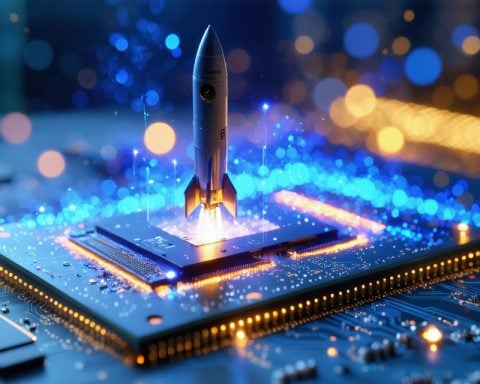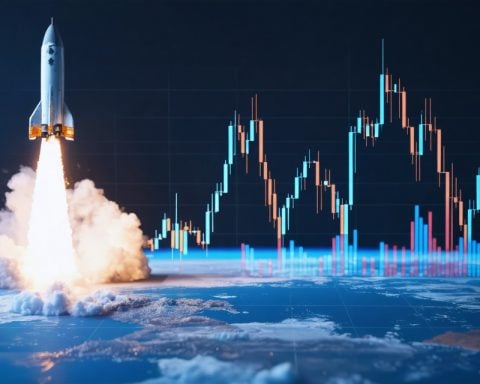- AI’s impact on Wall Street is significant, fueling gains across major indexes like the Dow Jones, S&P 500, and Nasdaq.
- AI is projected to become a $15.7 trillion market, driving incredible economic growth.
- Former President Donald Trump’s proposed tariffs could disrupt this growth, affecting key sectors like semiconductors.
- Semiconductors are crucial for AI development, and potential tariffs threaten to increase costs and complicate supply chains.
- Trade tensions, particularly with Asian partners like Taiwan, could be reignited due to these tariffs.
- Historical precedent suggests tariffs have negatively impacted U.S. manufacturing, potentially stifling innovation.
- Investors are advised to consider historical patterns, as AI’s trajectory may face challenges similar to past technological breakthroughs.
Wall Street. The financial epicenter where fortunes rise and fall with the rhythm of global events and murmurs of policy shifts. Artificial intelligence (AI) has been the golden child on this stage, powering unprecedented gains across the iconic Dow Jones, S&P 500, and Nasdaq indexes. With AI pegged as a $15.7 trillion market, the hype has been palpable, driving growth-fueled rallies and reshaping the landscape of investment.
Yet, amidst this optimism, a foreboding shadow lurks, launched from the lips of former president Donald Trump. His bold declaration on tariffs, a method used to shield domestic industries, could spell chaos for this booming cycle. Trump’s vision for an America-first AI strategy underlines a stark departure from his predecessor, but those 20 potent words have sparked intense apprehension: “The incentive is going to be they’re not going to want to pay…a tax.”
Potential tariffs loom large, threatening to uproot the hard-won advances achieved by AI stalwarts like Nvidia. Semiconductors, pivotal in AI’s march forward, sit at the center of this brewing storm. Moore’s Law may dictate rapid growth, but Trump’s trade tactics suggest a looming bottleneck. Potential tariffs on chip imports could inflate costs and rattle supply chains, stalling AI’s progress and reigniting trade tensions with key Asian partners, especially Taiwan.
History, it seems, is not on AI’s side. Similar past tariffs have pressured U.S. manufacturers, cutting into profits and innovation. Investors should heed these patterns, as history has shown that the ‘next big thing’ often encounters rocky terrain on its path to transformative success. As the old adage goes: those who cannot remember the past are condemned to repeat it.
Will Tariffs Derail AI’s Dominance on Wall Street?
Introduction
In recent years, artificial intelligence has surged to the forefront of Wall Street, driving unprecedented growth across major indexes such as the Dow Jones, S&P 500, and Nasdaq. As a projected $15.7 trillion market, AI holds immense potential for transformative economic gains. However, the looming specter of tariffs, particularly concerning semiconductors, poses a significant threat to this growth. With former President Donald Trump’s statements on imposing tariffs to protect domestic industries, investors must consider the potential implications on AI’s future trajectory.
How-To Steps & Life Hacks for Investors
1. Diversify Your Portfolio: While AI companies are attractive, diversify across different sectors to mitigate risks associated with geopolitical and trade uncertainties.
2. Monitor Policy Changes: Stay informed on developments in U.S. trade policy, especially regarding semiconductors, which can influence market dynamics significantly.
3. Leverage AI Tools for Analysis: Use AI-driven analytics platforms to gain insights into market trends and identify potential investment opportunities ahead of changes in economic policies.
Real-World Use Cases of AI
AI is revolutionizing industries beyond finance, including healthcare with predictive diagnostics, manufacturing with automation, and retail with personalized shopping experiences. Companies are integrating AI to improve efficiency, reduce costs, and drive innovation.
Market Forecasts & Industry Trends
According to PWC, AI could contribute $15.7 trillion to the global economy by 2030. Growth is expected to be driven by advancements in machine learning, increased computing power, and expanded AI applications across diverse industries. However, geopolitical tensions and trade policies may create volatility and affect the supply of key components like semiconductors.
Controversies & Limitations
While AI promises enhanced decision-making and efficiency, ethical concerns around data privacy, bias, and accountability persist. The industry’s reliance on semiconductors makes it vulnerable to supply chain disruptions caused by tariffs and geopolitical conflicts.
Features, Specs & Pricing
Semiconductors, essential to AI’s functionality, are mainly produced in Asia, with Taiwan being a crucial player. A tariff could raise costs, affecting the pricing of AI-enabled hardware and services.
Security & Sustainability
AI systems must prioritize cybersecurity to protect against data breaches. Additionally, with increasing energy demands, AI companies face pressure to adopt sustainable practices and green computing solutions.
Insights & Predictions
AI’s integration across sectors will continue to grow, but tariffs could introduce delays and increased costs. Companies may shift semiconductor manufacturing domestically to circumvent tariffs, leading to higher operational expenses initially.
Pros & Cons Overview
Pros:
– Significant potential for economic growth and innovation.
– Enhancements in efficiency and productivity across industries.
Cons:
– Vulnerability to geopolitical tensions and trade policies.
– Ethical and privacy concerns.
Actionable Recommendations
– Stay Informed: Regularly review trade news and technology reports to anticipate changes affecting AI investments.
– Advocate for Policy Stability: Engage with industry leaders and policymakers to express the importance of stable trade policies for innovation.
– Adopt AI Analytics: Utilize AI for robust investment decisions and risk management.
For more insights on investment strategies and market trends, visit Wall Street.
Conclusion
While AI’s potential remains vast and dynamic, external factors such as tariffs present real challenges. Investors should remain vigilant, diversifying and leveraging technology to navigate this evolving landscape. By understanding the interplay between technology advancements and trade policies, stakeholders can position themselves advantageously in the ever-shifting marketplace.



















